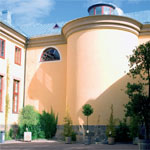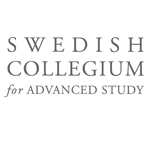SCAS News - 7 July, 2022
Network, Trust and Transparency
Network, trust and transparency - these three words have stuck with me from the symposium
”Opening the Ivory Tower Wide”, held at SCAS and BMC/UU, on May 18th-19th 2022. The
symposium was an event of the research theme ”Measurable Human” within the Natural Sciences
Program at SCAS, and organized by Nina Schiller, Erik Ullerås, Kristofer Rubin and Ulf Landegren.
During two days the participants of the symposium discussed and exemplified how academic
progress reaches society and makes a wider difference, but also challenges to this process, and
consequences for academic freedom.
I picked up the terms network, trust and transparency in the first coffee break. The previous
session had focused on how to navigate through the innovation system as an academic. Obviously,
there is not a standard solution that suits everybody. Access to a big - or least the right - network
improves the chances of meeting key people that can function as mentors, investors, or general
facilitators. Once on the innovation path, all parties need to be able to trust one another. Given that
the different stakeholders might have different interests, transparency is key to avoid misunder-
standings
and to understand each other’s expectations and needs.
Even if this particular chat at the coffee break was about innovation the same principle of network,
trust and transparency can be applied to many different approaches of outreach. Take communication
with the broader public, for example. A network, and/or collaboration, of scientists and science
communicators can facilitate dissemination of scientific results and scientific methods to a wider
audience.
This might happen via public lectures, podcasts like SCAS Talks, clips on YouTube,
activities at science
festivals or talking to patient organizations. In times of increasing disinformation
and even desinformation
it is of particular importance that the audience can trust the scientist or the
expert that is featured on national
news. The scientists have to be transparent - what are their areas
of expertise? Do they have in interest, or
advantage in for example propagating for a particular health
care measurement?
Networks between scientists and politicians and policy makers are essential to bring about change,
and to
promote evidence-based policies. Sometimes this is a process that takes many years, and some-
times decisions
have to be made fast. One example are the measurements that were put in place at the
onset of the Coronavirus
pandemic. Researchers in economics, policy makers and other stakeholders
had a fast and efficient exchange of
ideas to weigh the consequences of different scenarios against each
other. During the symposium we learned that
this process was facilitated through already existing think
tanks - networks - with professionals who could trust
each other. At the same time, health care measures
were staggering. Large scale testing of symptomatic patients
and their contacts was rolled out relatively
late, and there was an infected discussion whether the use of facial
masks would be beneficial or not.
Maybe platforms like economic think tanks might have helped, or they might
at least have contributed to
avoiding the infected public debate between scientists, endangering the trust of the
public in science.
At the same time as networking is a good starting point for outreach to society, one should also be careful
not to
get too comfortable with one another. Keeping one’s own research interest and agenda in mind is
an
important
dimension of striving to guarantee academic freedom. Freedom to do whatever research
one finds
fascinating,
freedom to choose the research angle and also the freedom to spend some decades
working on
developing a set
of scientific questions that at first do not seem to have an obvious benefit for
society. One
such example is the
discovery of the so-called genetic scissor Crispr/Cas9, a powerful tool for
precise genetic
engineering in all
organisms.
The scientists behind this discovery, Emmanuelle Charpentier
and Jennifer Doudna,
originally set
out to discover a
peculiar bacterial defense mechanism against viruses.
In 2020 they were rewarded
with the
Nobel Prize in Chemistry,
and Emmanuelle Charpentier has emphasized
many times that these discoveries
would not have been possible without
the time, trust and resources she
was given as a young researcher at
Umeå University. This discovery, like many other scientific milestones,
could not have been ”ordered” by
politicians or research funders.
In other cases, much could be achieved by modest means. The symposium showcased a story of a
critically
ill newborn child, who could not be diagnosed by genetic sequencing, despite the promise of
individual diagnosis
and treatment
for many diseases. In his dual role as both pediatrician at Karolinska
Institutet and researcher at
SciLifeLab, Petter Brodin could analyze the samples of the patient with state-of-
the-art methods and arrive to
a diagnosis. While the patient could
be treated and is now healthy this raises
the question of how the divide
between the hospital and the research lab can be closed. Many things are
already possible in modern health care,
but need to be facilitated through financing and national coordination.
After all, not every clinic has a top-notch
research laboratory, and the needed expertise, across the street.
Swedish universities have three central missions - research, teaching and outreach to society. Outreach is
often
referred
to
as the ”third task” and gives least merit in the academic world. Many researchers also
simply
experience a lack of time
to engage in the ”third task”, the bit that comes on top of everything else
once the
research and teaching is done. And
surely not everybody has the ability, talent and wish to also
innovate,
communicate and engage in policy making. During
the symposium the thought of ”educating the
educators” was
raised - after all a majority of the undergraduate and graduate students at universities will
not
end up in academic
research, but in places where they indeed can influence what science
can be used
for,
and thus influence society.
Different stakeholders should be close enough, but not too close, to create synergies where scientists can
maintain
their academic integrity at the same time as they can reach out to society with their research. Maybe
the creation
of more platforms, such as think tanks, where people can meet, could be a sustainable solution.
My mind wanders
off to SCAS, where researchers from different research fields, countries, and stages in
their career interact and find common ground. Places like that, that promotes outreach of science to society,
are much needed.
Written by Natalie von der Lehr, science journalist
Listen to the SCAS Talks Spotlight podcast episode Opening the Ivory Tower Wide here >>.
Download the programme for the symposium Opening the Ivory Tower Wide here >> (PDF)
(public part, 19 May)






